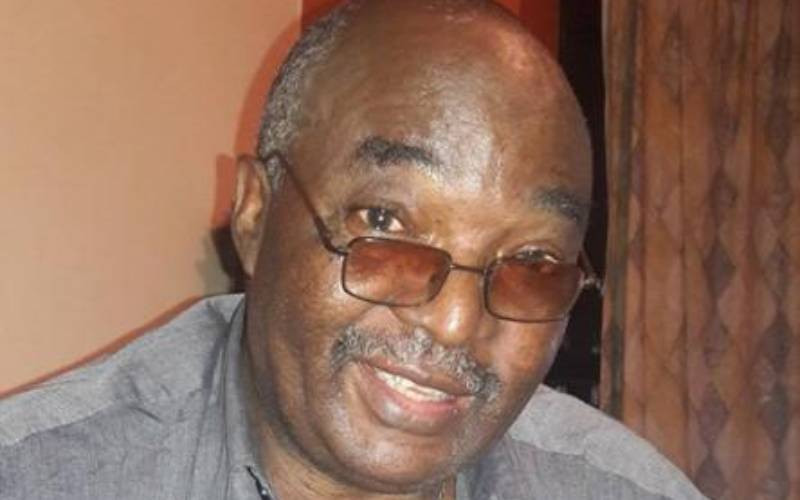By Amos Kareithi
Heavens have no wrath like a prophet defied and when the spurned prophet also happens to be a politician, the results can be catastrophic as happened to one shopkeeper.
Awed residents punctuate the myths and the legends around one such prophet, Elijah Masinde, with anecdotes as a former follower, Enos Simiyu recalls. " I was near the shop when Elijah pointed at a shopkeeper and shouted that by the end of some showers which were about to start, he would be no more."
At the time sun was shining brightly at Maeni trading centre just a short distance from Kimilili town but the heavens suddenly opened and rain came.
 |
The crowd that carried Masinde’s body on the day of burial |
Although some as the founder of the Dini Ya Msambwa regards Walumoli, Elijah was its undisputed leader and was persecuted by the colonial authorities for it. In 1955, DC C J Denton warned that Elijah posed a greater threat to law and order than Mau Mau, which had started a rebellion in central Kenya. In 1944, Masinde literally took on the colonialists by attacking a chief in Kimilili; he was jailed on February 14 after he refused to execute a bond of Sh500 to keep the peace after being found guilty of assault.
The colonial authorities certified him insane and locked him up at Mathari Mental Hospital for two years. Wafula, one of his sons talks of years of hardship the family endured while his father was in custody to a point his siblings had to drop out of school due to lack of school fees
Upon his release, Elijah intensified his attacks against the colonialists and was forced to go underground when the Government hunted him over a number of cases.
He was, however, betrayed by Omari Kuchikhi, who was privy to the hiding place, in the hope that he would be appointed a village headman.
Deported
Elijah prophesied that Kuchikhi would never secure the job he thirsted, proclaiming that he was destined to live off skins. He later eked out a living from selling hides at Chesamisi. On February 16, 1948, Elijah was arrested alongside four of his colleagues and charged with sedition and being a member of Dini Ya Msambwa.
He was deported to Lamu alongside Walumoli, and Wekuke, and their sect declared illegal while members were arrested and prosecuted. As Elijah languished in custody, Dini Ya Msambwa flourished, and linked with other organisations fighting for freedom, spread to West Pokot where 300 followers were jailed for 900 years.
Elijah was released on May 12 1960 after nationalists Jaramogi Oginga, Masinde Muliro, Tom Mboya and others pressured the colonial Government for the release of political detainees. Upon his release, he joined Kanu, a move which caused him problems with other area politicians among them Masinde Muliro, who belonged to Kenya African Democratitc Union (Kadu).
Politicians sympathetic to Kadu disowned Elijah and his religion during a meeting held in Kimilili in 1962, demanding that the sect and its leaders be expelled from Elgon Nyanza. Although Kenyatta’s Kanu regime tolerated Elijah and Dini Ya Msambwa for a time during which it was registered as a society, on May 16, 1964. But the marriage did not last long after Elijah lambasted the Government for not chasing settlers from their land.
Traditional ways
Stay informed. Subscribe to our newsletter
Apparently he took Dini Ya Msambwa’s license to promote traditional ways of worship too far in 1968, when he stormed Sisi Kwa Sisi bar and assaulted a bar maid, accusing her of introducing prostitution in Kimilili. On October 24, 1968, barely four years after its registration, his sect was banned by the very Kanu Government, which Elijah and his followers had fought so hard for.
In the meantime the followers spent most of their time fighting off criminal charges or fundraising for fines imposed on Elijah and hundreds of other followers who were always in and out of prison.
It is while serving his last stint at Kodiaga Prison at around 1986 that Elijah developed health problems that persisted long after he had been released. The ailing Elijah predicted his own death, and showed his son Wafula the exact place he would be buried.  |
The mausoleum that houses Elijah Masinde’s body. In the background is his first wife, Nanyama. Pictures: Amos Kareithi/File Standard |
"As I was taking him to the hospital in Lugulu in 1987, he pointed at a big kumwirurusia tree situated a distance from his house and declared that was where his grave would be." When he finally died on June 8,1987, the elders and followers of Dini Ya Msambwa amended his dying wish, and dug his grave in his compound.
"When the grave diggers started they unburied a human skeleton. This was strange, as no relative had been buried there. This was warning that my father’s wish had to be followed," Wafula adds. Twenty-four years after his death, the grave in which he was buried in a sitting position has become a shrine. Namanya, 93, keeps vigil from her mud-walled hut a few metres away. Every June thousands of pilgrims of the Dini Ya Msambwa faith pay homage to the shrine where they feast and pray facing Mt Elgon in remembrance of their ancestors and their ways of life.
 The Standard Group Plc is a
multi-media organization with investments in media platforms spanning newspaper
print operations, television, radio broadcasting, digital and online services. The
Standard Group is recognized as a leading multi-media house in Kenya with a key
influence in matters of national and international interest.
The Standard Group Plc is a
multi-media organization with investments in media platforms spanning newspaper
print operations, television, radio broadcasting, digital and online services. The
Standard Group is recognized as a leading multi-media house in Kenya with a key
influence in matters of national and international interest.
 The Standard Group Plc is a
multi-media organization with investments in media platforms spanning newspaper
print operations, television, radio broadcasting, digital and online services. The
Standard Group is recognized as a leading multi-media house in Kenya with a key
influence in matters of national and international interest.
The Standard Group Plc is a
multi-media organization with investments in media platforms spanning newspaper
print operations, television, radio broadcasting, digital and online services. The
Standard Group is recognized as a leading multi-media house in Kenya with a key
influence in matters of national and international interest.







